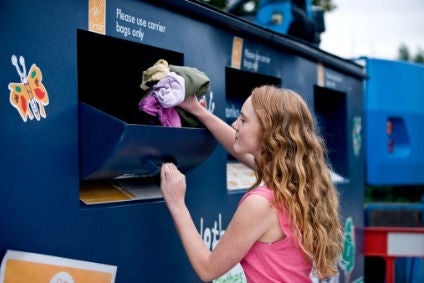
Apparel retailer Hennes & Mauritz (H&M) has hit back at press reports it sends “tonnes” of unused clothing to incinerators rather than recycling it, insisting this is a “rare” practice, only done in the event products do not meet the required safety regulations.
According to some press reports, the Swedish clothing giant and Danish apparel company Bestseller have “incinerated tonnes” of returned and unused clothing at a facility in Denmark, despite H&M encouraging customers to return used clothing to its retail stores so it can be recycled.

Discover B2B Marketing That Performs
Combine business intelligence and editorial excellence to reach engaged professionals across 36 leading media platforms.
A spokesperson for H&M told just-style today it was “puzzled” by the suggestion from media outlets that it would destroy products other than those that required it.
“There is absolutely no reason for us to do such a thing,” the spokesperson asserts. “The products media refers to have been tested in external laboratories. The test results show that one of the products is mould infested and the other product [has] high levels of lead.
“When test results show that certain products don’t fulfil our safety regulations they should not by any circumstances be neither sold to our customer or be recycled. They will, therefore, be sent to destruction in accordance with our global safety routines. H&M has one of the strictest chemical restrictions in the industry and we do regular testing, often in external laboratories. Accordingly, the restrictions often go further than the law demands as we want our customers to feel totally safe to use our products”.
H&M also confirmed that garments that cannot be sold due to reasons other than health and safety are either donated to charity organisations or re-used through re-use programmes or recycling companies. Some are also sold at a lower price in the company’s sales.

US Tariffs are shifting - will you react or anticipate?
Don’t let policy changes catch you off guard. Stay proactive with real-time data and expert analysis.
By GlobalData“We also actively move garments to stores or markets where we see a greater demand or store them to the next season. As a last resort, we consider external buyers of our overstock,” adds the spokesperson.
Last week the company announced it was investing in Swedish textile recycling technology specialist Re:newcell, which converts old textiles into pulp to produce new clothing – part of its move to use 100% recycled or other sustainably sourced material by 2030.
H&M invests in more sustainable sourcing
Meanwhile, Bestseller – owner of brands including Jack&Jones, Noisy May, Villa Clothes and Vero Moda – told just-style it wanted to “emphasise [it] does not dispose of undamaged products.”
The company said items affected mainly by water and mould damage in transportation were disposed of “in the most economically and environmentally suitable way” if they could not be sold or reused in any other way due to consumer safety. This includes down-cycling: converting damaged products to energy through combustion.
The number of damaged products converted into energy constitutes approximately 0.1 per mille of the total number of products being shipped to its central warehouse, it adds.
“Bestseller has no financial or environmental interest in destroying undamaged products,” a statement says. “We always strive to optimise our buying process to have the right products, at the right time and at the right price in the stores.”
Handling excess product and claims is at the individual store’s discretion, says Bestseller, with the majority of stores selling excess stock at lower prices. Others send them to the recycling company I:CO that either redistributes the products for reuse or recycles the fibres for insulation in other industries or as playground surfaces. Some excess is returned to Bestseller’s central warehouse which then resells the items to other markets.
But, says the retailer, damaged products “make up an infinitely small percentage of the goods we produce.”
“The real waste challenge is what happens to products after consumers are done using them. We promote the message to our consumers that used textiles are a valuable resource and not waste. In 2017, we started a [campaign] with the Danish Red Cross that aimed at collecting as much used clothing as possible for either resale or, if in poor condition, recycling. Throughout the year, we also donate clothes for various other charity purposes, and resell second-hand clothes.
“Post-consumer waste is a systemic challenge that one brand can’t solve on its own. Bestseller is working with the Ellen McArthur Foundation and the Global Fashion Agenda to discuss and promote circular economy infrastructure challenges and solutions.”
In August, Bestseller joined the likes of H&M, US department store retailer Target Corp, and French luxury goods group Kering as a strategic partner in the Global Fashion Agenda (GFA), a group working to set a common direction for industry efforts on sustainability in fashion.





